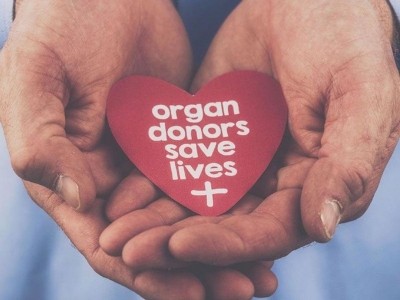IANS Photo

IANS
Societal reservations, lack of awareness and infrastructure are the major roadblocks for active organ donations in India, according to health experts on Wednesday.
India faces the lowest organ donation rate worldwide, with a mere 0.1 per cent of the population donating their organs after death in stark contrast to 70-80 per cent in Western countries.
"Currently there is a huge gap between patients who need organs and the actual organs available for transplantation. The waiting list for kidneys and liver can go up to several years. The heart and lung recipients are completely dependent on cadaveric organ donation programme, hence it is imperative that we as a country pledge for this cause," Rahul Pandit, Chair, Critical Care, Sir H N Reliance Foundation Hospital, Mumbai, told IANS.
Traditionally two concepts have been practiced in India, live related donation and cadaveric organ donation, he explained.
Live related donation involves removing a healthy organ usually from recipients near relatives as described in the organ donation Act and transplanting it in the recipient. However, this practice is only limited to kidney and liver in solid organ transplantation.
Cadaveric organ donation is organ donation after brain stem death. This is possible in patients who have an irreversible neurological condition, who are on a ventilator in ICU with no brain function.
This process, if the family consents then almost 8-9 organs -- cornea, heart, lungs, 2 kidneys, liver, pancreatic islets cells, uterus, both hands, skin, bone and muscle tendons -- can be donated, the doctor said.
"While there has been a slight improvement in harvesting organs from deceased donors, with an increase in the average number of transplants per donor, it remains insufficient. For example, out of 12,387 harvested organs in 2021, only slightly over 14 per cent were from deceased donors," Yasir Rizvi, Associate Director & Senior Consultant - Nephrology at Dharamshila Narayana Superspeciality Hospital, told IANS.
Rajesh Aggarwal, Chief and Sr. Consultant - Kidney Transplant & Dialysis Department at Sri Balaji Action Medical Institute, explained that "myths surrounding brain death contribute to considerable organ wastage, with India losing around 2 lakh kidneys and other vital organs annually".
Properly harvesting even 5-10 per cent of all brain deaths for organ donation could render the need for living donors obsolete. The issue is particularly pronounced in heart transplants, with challenges like cost and expertise availability in different cities exacerbating the problem.
"India faces a critical challenge with a dismal organ donation rate of 0.86 per million people, necessitating a drastic improvement. Despite a notable post-Covid resurgence in transplant activities, achieving over 15,000 transplants in 2022 with a 27 per cent annual increase, societal reservations remain a significant obstacle. The country grapples with a demand-supply gap in organ donation and transplants due to a lack of awareness and deep-rooted superstitions," Aggarwal told IANS.
Rizvi also noted limited awareness and infrastructure as a significant challenge in organ donation in India. Despite some progress, there exists a substantial gap between organ demand and supply, with only 0.1 per cent of the population donating their organs after death, he said.
"The situation demands urgent action, given the organ shortage crisis in the country. Public awareness campaigns are crucial to enhance organ donation rates, and collaboration between the medical fraternity and policymakers is necessary to streamline donation processes.
"Establishing transparent organ registries and strengthening deceased organ donation infrastructure are pivotal steps for India to advance in organ donation and transplantation," he said.
To boost organ donation practices, the health experts called for a comprehensive approach. Education campaigns can debunk myths and emphasise the impact of donations on saving lives, they said.




